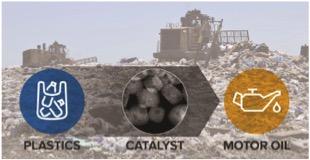
Our civilization relies on synthetic polymers for all aspects of modern life, yet inefficient recycling and extremely slow environmental degradation of plastics are causing increasing concern about their widespread use. After a single use, many of these materials are currently treated as waste, under-utilizing their inherent chemical and energy value. In this study, energy-rich polyethylene (PE) macromolecules are catalytically transformed into value-added products by hydrogenolysis using well-dispersed Pt nanoparticles (NPs) supported on SrTiO3 perovskite nanocuboids by atomic layer deposition (ALD). Pt/SrTiO3 completely converts PE (Mn = 8,000 – 158,000 Da) or a single-use plastic bag (Mn = 31,000 Da) into high-quality liquid products, such as lubricant and wax, characterized by a narrow distribution of oligomeric chains, at 170 psi H2 and 300 °C under solvent-free conditions. The binding of PE onto the catalyst surface contributes to the molecular number (Mn) and the narrow polydispersity (Ð) of the final liquid product. Solid-state nuclear magnetic resonance (ssNMR) of 13C-enriched PE adsorption studies and density functional theory (DFT) computations suggest that PE adsorption is more favorable on Pt sites than that on the SrTiO3 support. Smaller Pt NPs with higher concentrations of undercoordinated Pt sites over-hydrogenolyzed PE to undesired light hydrocarbons.
This work was supported as part of Catalysis for Upcycling Polymers (CUP) by the U.S. Department of Energy (DOE), Office of Basic Energy Sciences, Division of Chemical Sciences, Geosciences, and Biosciences, Catalysis Science Program under Contract DE-AC-02-06CH11357 (Argonne National Laboratory) and DE-AC-02 07CH11358 (Ames Laboratory).
